CX554101 Marketing Plan: Starbucks Bubble Tea in New Zealand (2024)
VerifiedAdded on 2022/12/22
|24
|5458
|1
Report
AI Summary
This report presents a comprehensive marketing plan for the introduction of Starbucks' bubble tea in the New Zealand market. It begins with an executive summary and proceeds with a detailed situational analysis, including competitive forces, regulatory, economic, socio-cultural, technological, and demographic factors. The report examines the market size, customer needs and trends, and competitor analysis, with a focus on Costa Coffee. A SWOT analysis identifies Starbucks' strengths, weaknesses, opportunities, and threats, followed by a Porter's Five Forces analysis to assess the external environment. The plan outlines market segmentation, target market profiles, and product positioning strategies. Marketing objectives and strategies are defined, encompassing product, pricing, distribution, and promotional decisions. The report concludes with an integration and link section, along with coordination and control mechanisms to ensure the successful implementation of the marketing plan. References are provided for all sources used within the report.
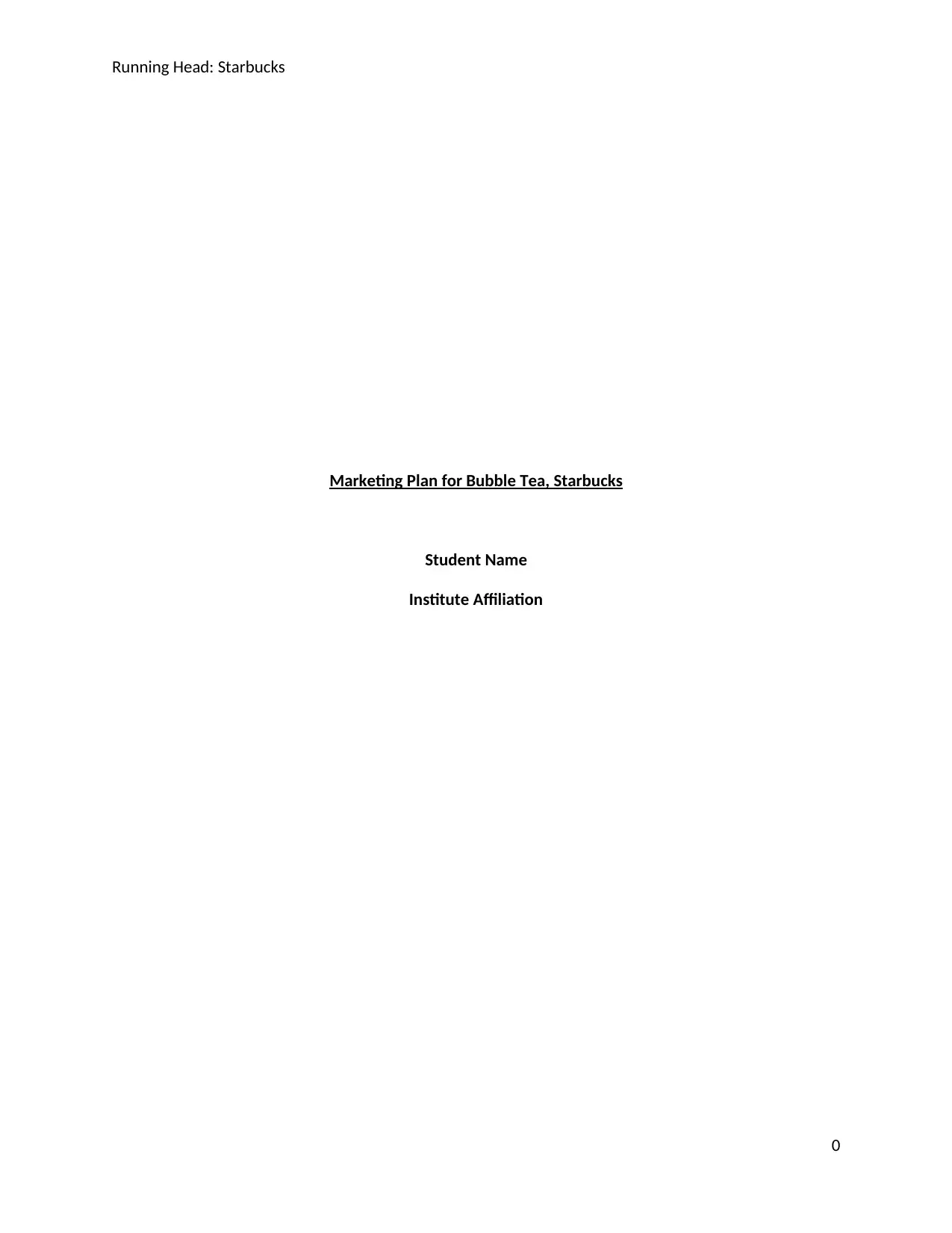
Running Head: Starbucks
Marketing Plan for Bubble Tea, Starbucks
Student Name
Institute Affiliation
0
Marketing Plan for Bubble Tea, Starbucks
Student Name
Institute Affiliation
0
Paraphrase This Document
Need a fresh take? Get an instant paraphrase of this document with our AI Paraphraser
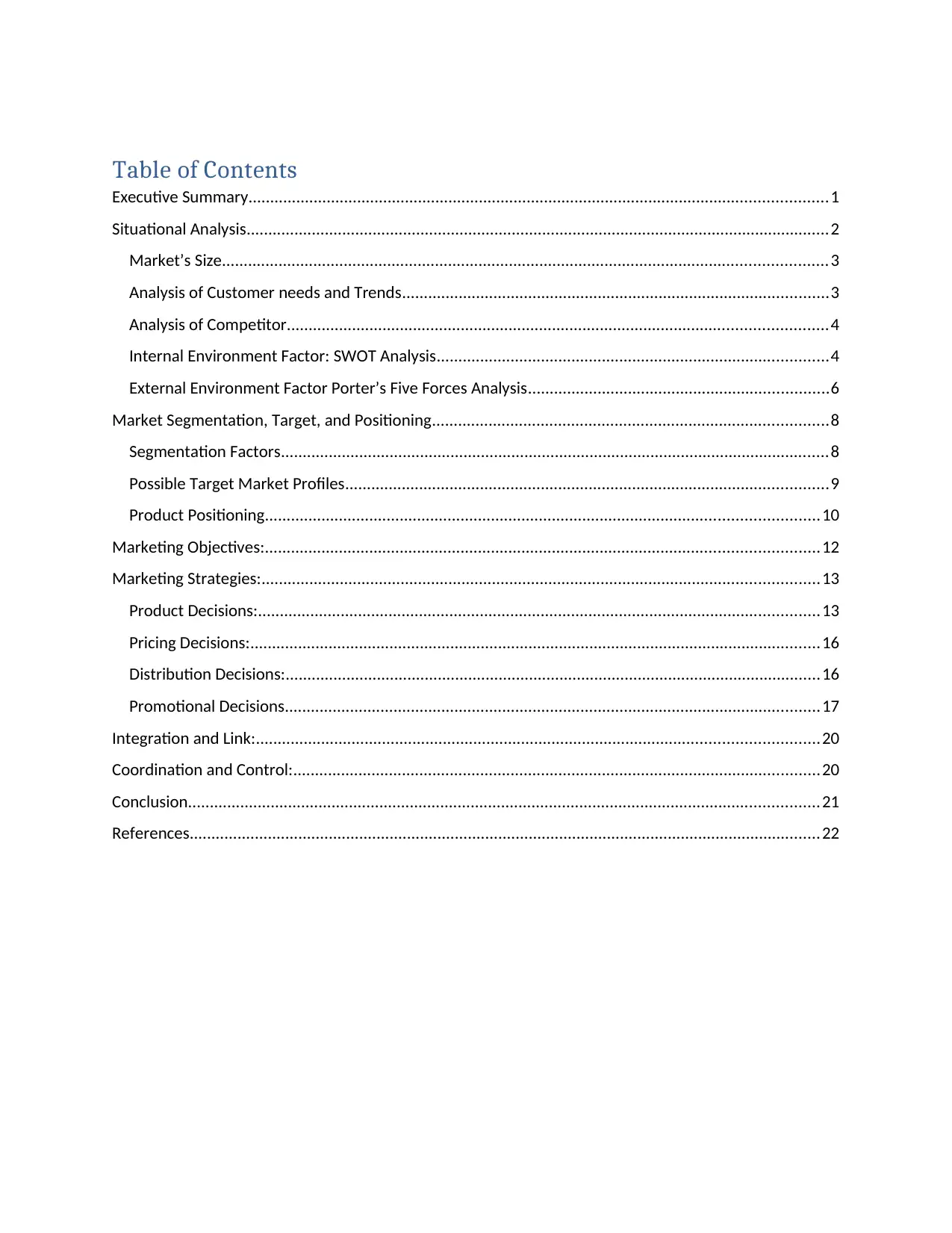
Table of Contents
Executive Summary.....................................................................................................................................1
Situational Analysis......................................................................................................................................2
Market’s Size...........................................................................................................................................3
Analysis of Customer needs and Trends..................................................................................................3
Analysis of Competitor............................................................................................................................4
Internal Environment Factor: SWOT Analysis..........................................................................................4
External Environment Factor Porter’s Five Forces Analysis.....................................................................6
Market Segmentation, Target, and Positioning...........................................................................................8
Segmentation Factors..............................................................................................................................8
Possible Target Market Profiles...............................................................................................................9
Product Positioning...............................................................................................................................10
Marketing Objectives:...............................................................................................................................12
Marketing Strategies:................................................................................................................................13
Product Decisions:.................................................................................................................................13
Pricing Decisions:...................................................................................................................................16
Distribution Decisions:...........................................................................................................................16
Promotional Decisions...........................................................................................................................17
Integration and Link:.................................................................................................................................20
Coordination and Control:.........................................................................................................................20
Conclusion.................................................................................................................................................21
References.................................................................................................................................................22
Executive Summary.....................................................................................................................................1
Situational Analysis......................................................................................................................................2
Market’s Size...........................................................................................................................................3
Analysis of Customer needs and Trends..................................................................................................3
Analysis of Competitor............................................................................................................................4
Internal Environment Factor: SWOT Analysis..........................................................................................4
External Environment Factor Porter’s Five Forces Analysis.....................................................................6
Market Segmentation, Target, and Positioning...........................................................................................8
Segmentation Factors..............................................................................................................................8
Possible Target Market Profiles...............................................................................................................9
Product Positioning...............................................................................................................................10
Marketing Objectives:...............................................................................................................................12
Marketing Strategies:................................................................................................................................13
Product Decisions:.................................................................................................................................13
Pricing Decisions:...................................................................................................................................16
Distribution Decisions:...........................................................................................................................16
Promotional Decisions...........................................................................................................................17
Integration and Link:.................................................................................................................................20
Coordination and Control:.........................................................................................................................20
Conclusion.................................................................................................................................................21
References.................................................................................................................................................22
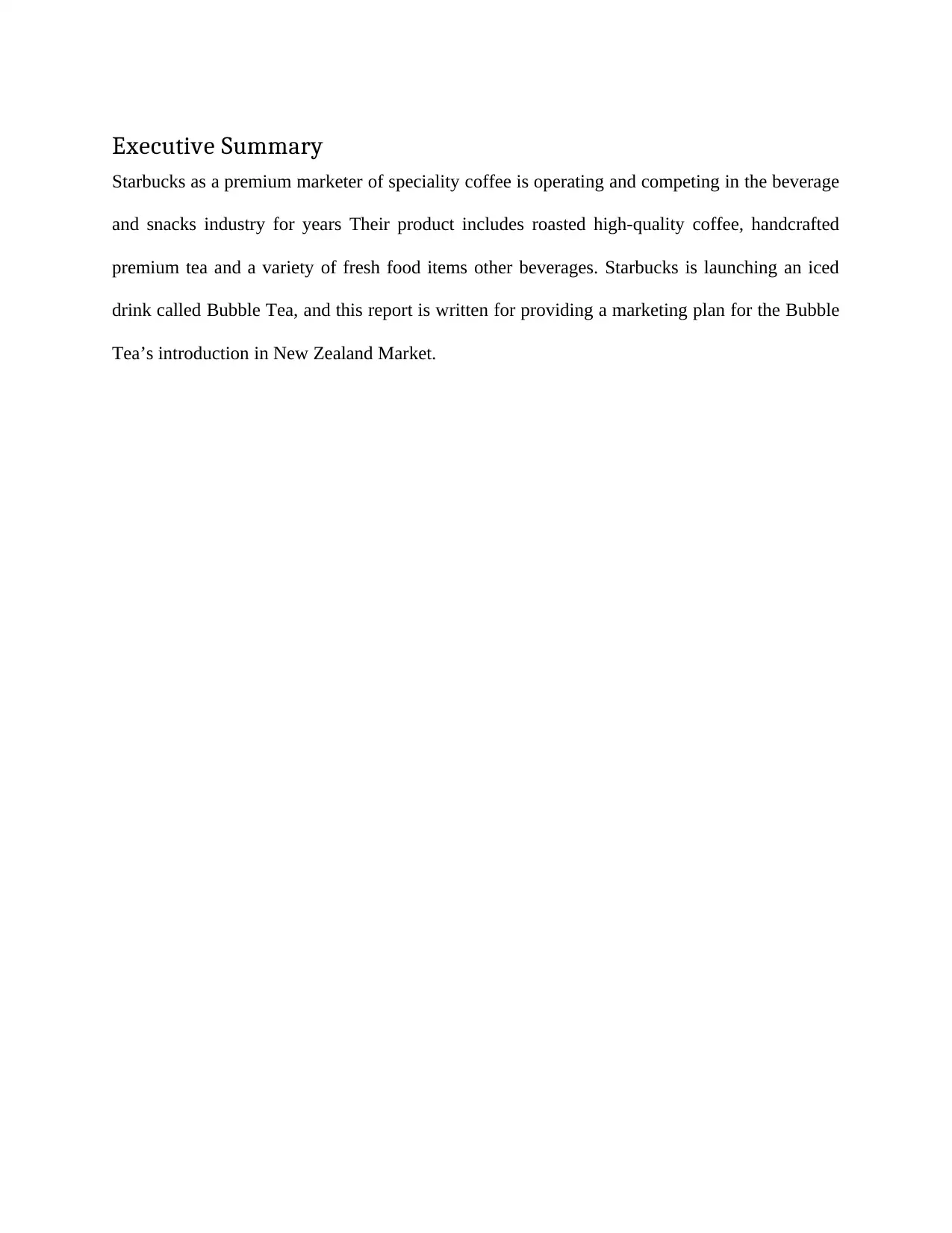
Executive Summary
Starbucks as a premium marketer of speciality coffee is operating and competing in the beverage
and snacks industry for years Their product includes roasted high-quality coffee, handcrafted
premium tea and a variety of fresh food items other beverages. Starbucks is launching an iced
drink called Bubble Tea, and this report is written for providing a marketing plan for the Bubble
Tea’s introduction in New Zealand Market.
Starbucks as a premium marketer of speciality coffee is operating and competing in the beverage
and snacks industry for years Their product includes roasted high-quality coffee, handcrafted
premium tea and a variety of fresh food items other beverages. Starbucks is launching an iced
drink called Bubble Tea, and this report is written for providing a marketing plan for the Bubble
Tea’s introduction in New Zealand Market.
⊘ This is a preview!⊘
Do you want full access?
Subscribe today to unlock all pages.

Trusted by 1+ million students worldwide
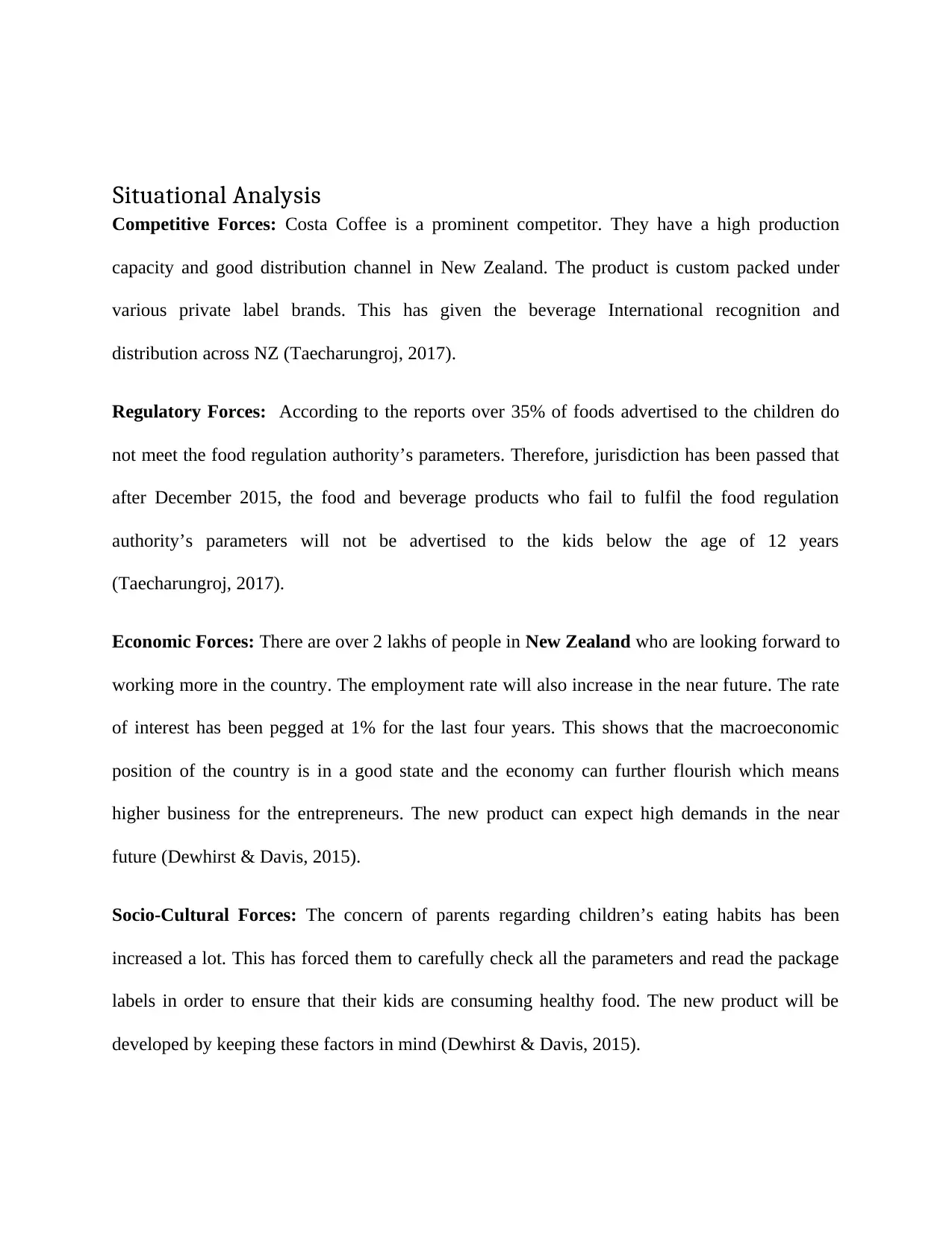
Situational Analysis
Competitive Forces: Costa Coffee is a prominent competitor. They have a high production
capacity and good distribution channel in New Zealand. The product is custom packed under
various private label brands. This has given the beverage International recognition and
distribution across NZ (Taecharungroj, 2017).
Regulatory Forces: According to the reports over 35% of foods advertised to the children do
not meet the food regulation authority’s parameters. Therefore, jurisdiction has been passed that
after December 2015, the food and beverage products who fail to fulfil the food regulation
authority’s parameters will not be advertised to the kids below the age of 12 years
(Taecharungroj, 2017).
Economic Forces: There are over 2 lakhs of people in New Zealand who are looking forward to
working more in the country. The employment rate will also increase in the near future. The rate
of interest has been pegged at 1% for the last four years. This shows that the macroeconomic
position of the country is in a good state and the economy can further flourish which means
higher business for the entrepreneurs. The new product can expect high demands in the near
future (Dewhirst & Davis, 2015).
Socio-Cultural Forces: The concern of parents regarding children’s eating habits has been
increased a lot. This has forced them to carefully check all the parameters and read the package
labels in order to ensure that their kids are consuming healthy food. The new product will be
developed by keeping these factors in mind (Dewhirst & Davis, 2015).
Competitive Forces: Costa Coffee is a prominent competitor. They have a high production
capacity and good distribution channel in New Zealand. The product is custom packed under
various private label brands. This has given the beverage International recognition and
distribution across NZ (Taecharungroj, 2017).
Regulatory Forces: According to the reports over 35% of foods advertised to the children do
not meet the food regulation authority’s parameters. Therefore, jurisdiction has been passed that
after December 2015, the food and beverage products who fail to fulfil the food regulation
authority’s parameters will not be advertised to the kids below the age of 12 years
(Taecharungroj, 2017).
Economic Forces: There are over 2 lakhs of people in New Zealand who are looking forward to
working more in the country. The employment rate will also increase in the near future. The rate
of interest has been pegged at 1% for the last four years. This shows that the macroeconomic
position of the country is in a good state and the economy can further flourish which means
higher business for the entrepreneurs. The new product can expect high demands in the near
future (Dewhirst & Davis, 2015).
Socio-Cultural Forces: The concern of parents regarding children’s eating habits has been
increased a lot. This has forced them to carefully check all the parameters and read the package
labels in order to ensure that their kids are consuming healthy food. The new product will be
developed by keeping these factors in mind (Dewhirst & Davis, 2015).
Paraphrase This Document
Need a fresh take? Get an instant paraphrase of this document with our AI Paraphraser
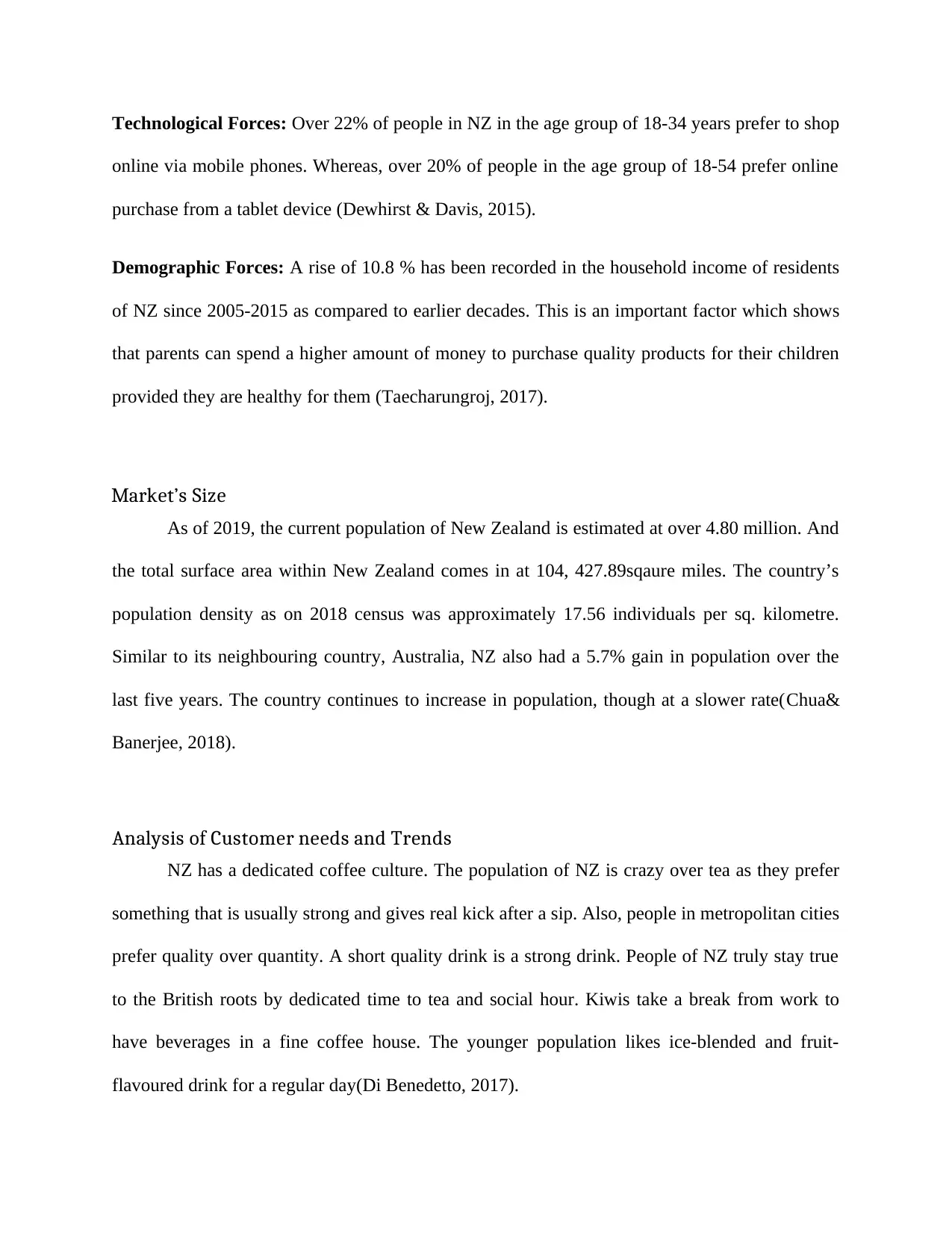
Technological Forces: Over 22% of people in NZ in the age group of 18-34 years prefer to shop
online via mobile phones. Whereas, over 20% of people in the age group of 18-54 prefer online
purchase from a tablet device (Dewhirst & Davis, 2015).
Demographic Forces: A rise of 10.8 % has been recorded in the household income of residents
of NZ since 2005-2015 as compared to earlier decades. This is an important factor which shows
that parents can spend a higher amount of money to purchase quality products for their children
provided they are healthy for them (Taecharungroj, 2017).
Market’s Size
As of 2019, the current population of New Zealand is estimated at over 4.80 million. And
the total surface area within New Zealand comes in at 104, 427.89sqaure miles. The country’s
population density as on 2018 census was approximately 17.56 individuals per sq. kilometre.
Similar to its neighbouring country, Australia, NZ also had a 5.7% gain in population over the
last five years. The country continues to increase in population, though at a slower rate(Chua&
Banerjee, 2018).
Analysis of Customer needs and Trends
NZ has a dedicated coffee culture. The population of NZ is crazy over tea as they prefer
something that is usually strong and gives real kick after a sip. Also, people in metropolitan cities
prefer quality over quantity. A short quality drink is a strong drink. People of NZ truly stay true
to the British roots by dedicated time to tea and social hour. Kiwis take a break from work to
have beverages in a fine coffee house. The younger population likes ice-blended and fruit-
flavoured drink for a regular day(Di Benedetto, 2017).
online via mobile phones. Whereas, over 20% of people in the age group of 18-54 prefer online
purchase from a tablet device (Dewhirst & Davis, 2015).
Demographic Forces: A rise of 10.8 % has been recorded in the household income of residents
of NZ since 2005-2015 as compared to earlier decades. This is an important factor which shows
that parents can spend a higher amount of money to purchase quality products for their children
provided they are healthy for them (Taecharungroj, 2017).
Market’s Size
As of 2019, the current population of New Zealand is estimated at over 4.80 million. And
the total surface area within New Zealand comes in at 104, 427.89sqaure miles. The country’s
population density as on 2018 census was approximately 17.56 individuals per sq. kilometre.
Similar to its neighbouring country, Australia, NZ also had a 5.7% gain in population over the
last five years. The country continues to increase in population, though at a slower rate(Chua&
Banerjee, 2018).
Analysis of Customer needs and Trends
NZ has a dedicated coffee culture. The population of NZ is crazy over tea as they prefer
something that is usually strong and gives real kick after a sip. Also, people in metropolitan cities
prefer quality over quantity. A short quality drink is a strong drink. People of NZ truly stay true
to the British roots by dedicated time to tea and social hour. Kiwis take a break from work to
have beverages in a fine coffee house. The younger population likes ice-blended and fruit-
flavoured drink for a regular day(Di Benedetto, 2017).
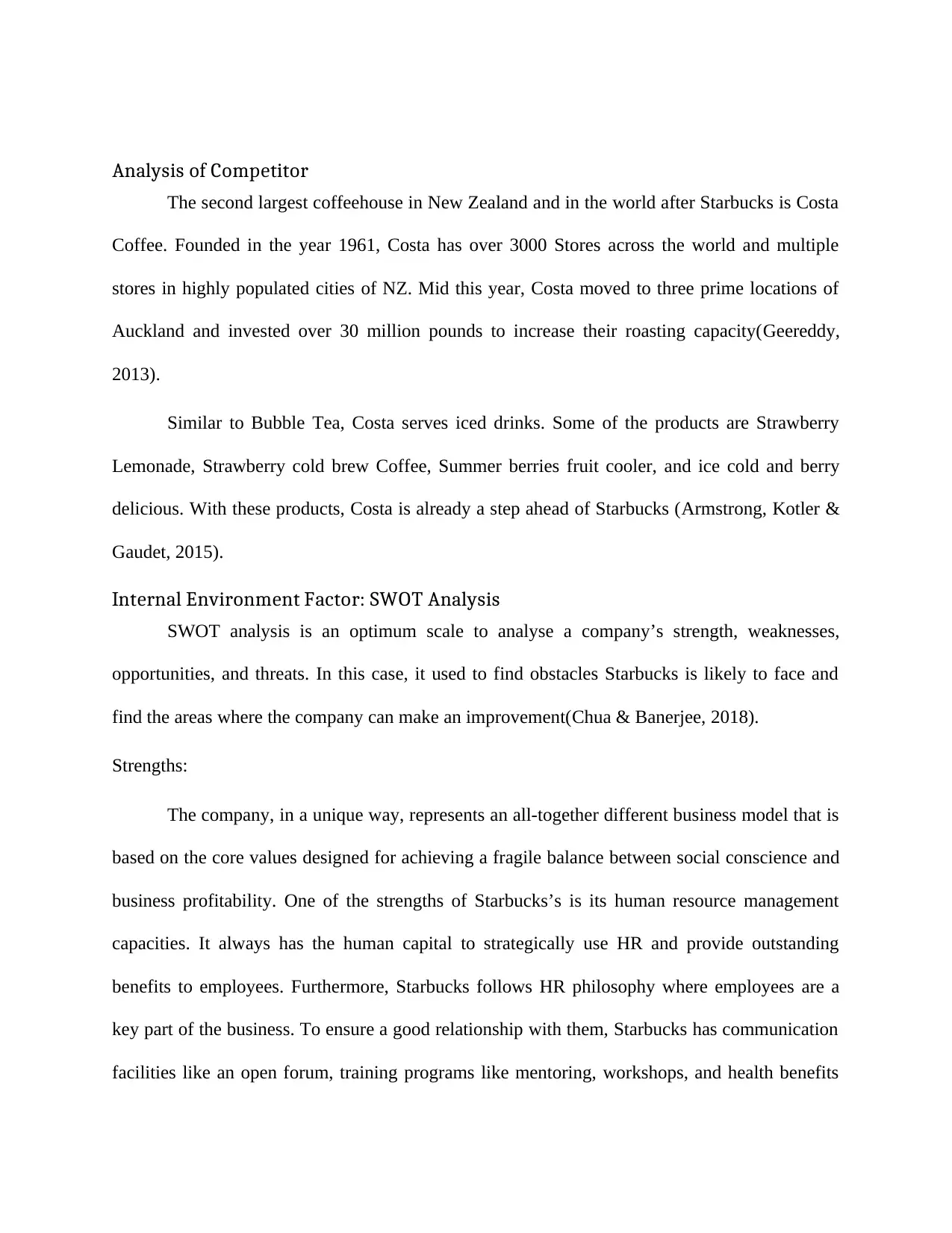
Analysis of Competitor
The second largest coffeehouse in New Zealand and in the world after Starbucks is Costa
Coffee. Founded in the year 1961, Costa has over 3000 Stores across the world and multiple
stores in highly populated cities of NZ. Mid this year, Costa moved to three prime locations of
Auckland and invested over 30 million pounds to increase their roasting capacity(Geereddy,
2013).
Similar to Bubble Tea, Costa serves iced drinks. Some of the products are Strawberry
Lemonade, Strawberry cold brew Coffee, Summer berries fruit cooler, and ice cold and berry
delicious. With these products, Costa is already a step ahead of Starbucks (Armstrong, Kotler &
Gaudet, 2015).
Internal Environment Factor: SWOT Analysis
SWOT analysis is an optimum scale to analyse a company’s strength, weaknesses,
opportunities, and threats. In this case, it used to find obstacles Starbucks is likely to face and
find the areas where the company can make an improvement(Chua & Banerjee, 2018).
Strengths:
The company, in a unique way, represents an all-together different business model that is
based on the core values designed for achieving a fragile balance between social conscience and
business profitability. One of the strengths of Starbucks’s is its human resource management
capacities. It always has the human capital to strategically use HR and provide outstanding
benefits to employees. Furthermore, Starbucks follows HR philosophy where employees are a
key part of the business. To ensure a good relationship with them, Starbucks has communication
facilities like an open forum, training programs like mentoring, workshops, and health benefits
The second largest coffeehouse in New Zealand and in the world after Starbucks is Costa
Coffee. Founded in the year 1961, Costa has over 3000 Stores across the world and multiple
stores in highly populated cities of NZ. Mid this year, Costa moved to three prime locations of
Auckland and invested over 30 million pounds to increase their roasting capacity(Geereddy,
2013).
Similar to Bubble Tea, Costa serves iced drinks. Some of the products are Strawberry
Lemonade, Strawberry cold brew Coffee, Summer berries fruit cooler, and ice cold and berry
delicious. With these products, Costa is already a step ahead of Starbucks (Armstrong, Kotler &
Gaudet, 2015).
Internal Environment Factor: SWOT Analysis
SWOT analysis is an optimum scale to analyse a company’s strength, weaknesses,
opportunities, and threats. In this case, it used to find obstacles Starbucks is likely to face and
find the areas where the company can make an improvement(Chua & Banerjee, 2018).
Strengths:
The company, in a unique way, represents an all-together different business model that is
based on the core values designed for achieving a fragile balance between social conscience and
business profitability. One of the strengths of Starbucks’s is its human resource management
capacities. It always has the human capital to strategically use HR and provide outstanding
benefits to employees. Furthermore, Starbucks follows HR philosophy where employees are a
key part of the business. To ensure a good relationship with them, Starbucks has communication
facilities like an open forum, training programs like mentoring, workshops, and health benefits
⊘ This is a preview!⊘
Do you want full access?
Subscribe today to unlock all pages.

Trusted by 1+ million students worldwide
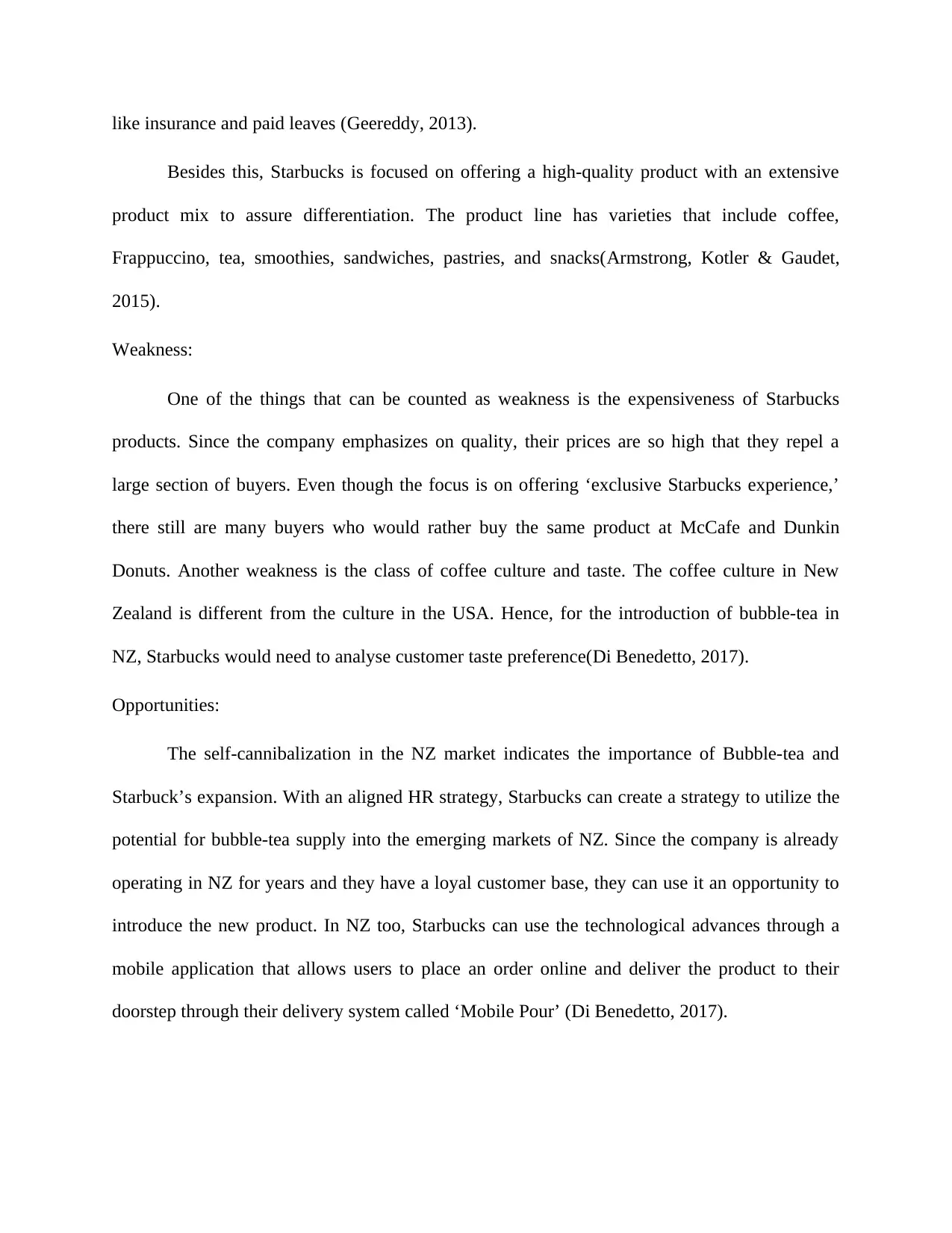
like insurance and paid leaves (Geereddy, 2013).
Besides this, Starbucks is focused on offering a high-quality product with an extensive
product mix to assure differentiation. The product line has varieties that include coffee,
Frappuccino, tea, smoothies, sandwiches, pastries, and snacks(Armstrong, Kotler & Gaudet,
2015).
Weakness:
One of the things that can be counted as weakness is the expensiveness of Starbucks
products. Since the company emphasizes on quality, their prices are so high that they repel a
large section of buyers. Even though the focus is on offering ‘exclusive Starbucks experience,’
there still are many buyers who would rather buy the same product at McCafe and Dunkin
Donuts. Another weakness is the class of coffee culture and taste. The coffee culture in New
Zealand is different from the culture in the USA. Hence, for the introduction of bubble-tea in
NZ, Starbucks would need to analyse customer taste preference(Di Benedetto, 2017).
Opportunities:
The self-cannibalization in the NZ market indicates the importance of Bubble-tea and
Starbuck’s expansion. With an aligned HR strategy, Starbucks can create a strategy to utilize the
potential for bubble-tea supply into the emerging markets of NZ. Since the company is already
operating in NZ for years and they have a loyal customer base, they can use it an opportunity to
introduce the new product. In NZ too, Starbucks can use the technological advances through a
mobile application that allows users to place an order online and deliver the product to their
doorstep through their delivery system called ‘Mobile Pour’ (Di Benedetto, 2017).
Besides this, Starbucks is focused on offering a high-quality product with an extensive
product mix to assure differentiation. The product line has varieties that include coffee,
Frappuccino, tea, smoothies, sandwiches, pastries, and snacks(Armstrong, Kotler & Gaudet,
2015).
Weakness:
One of the things that can be counted as weakness is the expensiveness of Starbucks
products. Since the company emphasizes on quality, their prices are so high that they repel a
large section of buyers. Even though the focus is on offering ‘exclusive Starbucks experience,’
there still are many buyers who would rather buy the same product at McCafe and Dunkin
Donuts. Another weakness is the class of coffee culture and taste. The coffee culture in New
Zealand is different from the culture in the USA. Hence, for the introduction of bubble-tea in
NZ, Starbucks would need to analyse customer taste preference(Di Benedetto, 2017).
Opportunities:
The self-cannibalization in the NZ market indicates the importance of Bubble-tea and
Starbuck’s expansion. With an aligned HR strategy, Starbucks can create a strategy to utilize the
potential for bubble-tea supply into the emerging markets of NZ. Since the company is already
operating in NZ for years and they have a loyal customer base, they can use it an opportunity to
introduce the new product. In NZ too, Starbucks can use the technological advances through a
mobile application that allows users to place an order online and deliver the product to their
doorstep through their delivery system called ‘Mobile Pour’ (Di Benedetto, 2017).
Paraphrase This Document
Need a fresh take? Get an instant paraphrase of this document with our AI Paraphraser
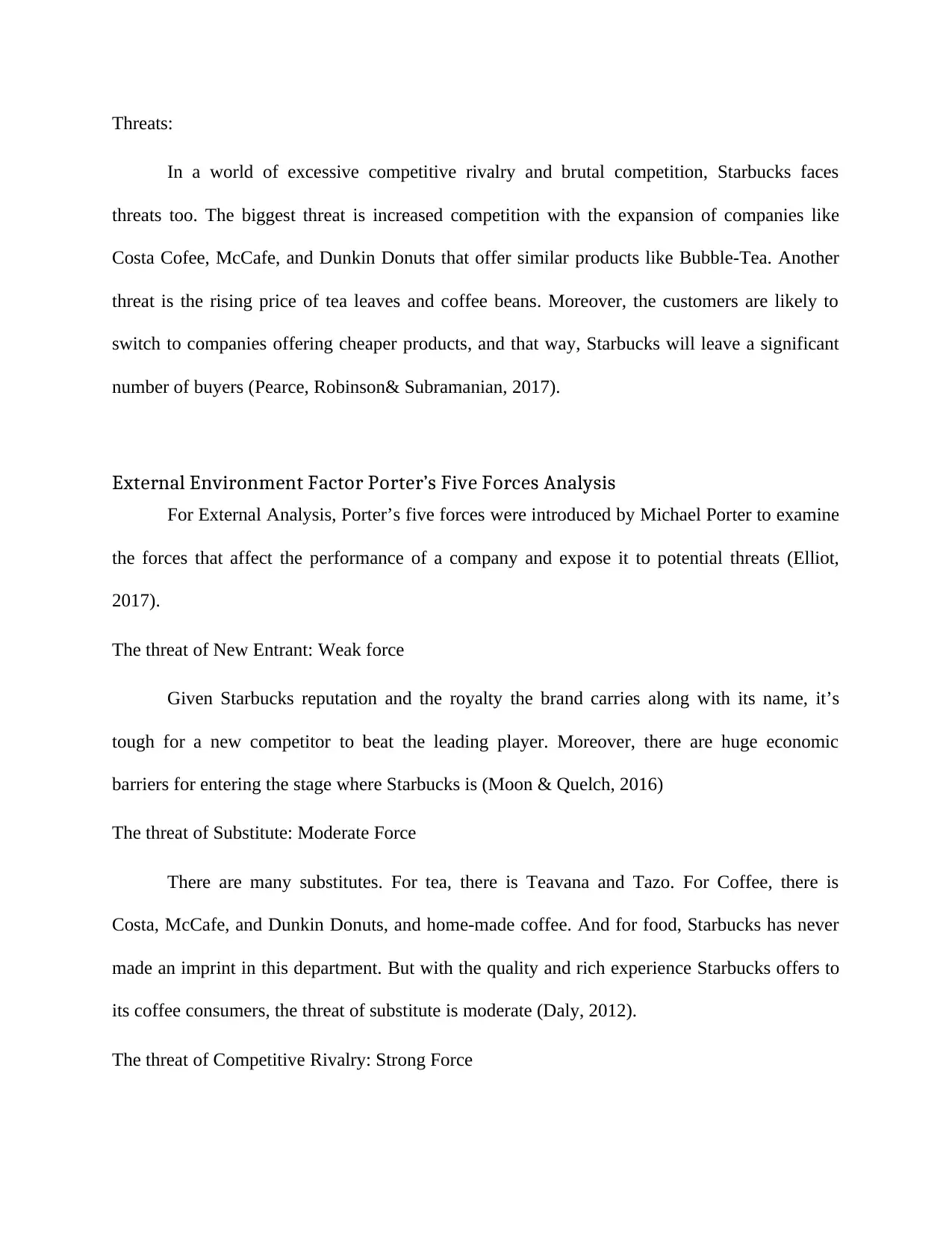
Threats:
In a world of excessive competitive rivalry and brutal competition, Starbucks faces
threats too. The biggest threat is increased competition with the expansion of companies like
Costa Cofee, McCafe, and Dunkin Donuts that offer similar products like Bubble-Tea. Another
threat is the rising price of tea leaves and coffee beans. Moreover, the customers are likely to
switch to companies offering cheaper products, and that way, Starbucks will leave a significant
number of buyers (Pearce, Robinson& Subramanian, 2017).
External Environment Factor Porter’s Five Forces Analysis
For External Analysis, Porter’s five forces were introduced by Michael Porter to examine
the forces that affect the performance of a company and expose it to potential threats (Elliot,
2017).
The threat of New Entrant: Weak force
Given Starbucks reputation and the royalty the brand carries along with its name, it’s
tough for a new competitor to beat the leading player. Moreover, there are huge economic
barriers for entering the stage where Starbucks is (Moon & Quelch, 2016)
The threat of Substitute: Moderate Force
There are many substitutes. For tea, there is Teavana and Tazo. For Coffee, there is
Costa, McCafe, and Dunkin Donuts, and home-made coffee. And for food, Starbucks has never
made an imprint in this department. But with the quality and rich experience Starbucks offers to
its coffee consumers, the threat of substitute is moderate (Daly, 2012).
The threat of Competitive Rivalry: Strong Force
In a world of excessive competitive rivalry and brutal competition, Starbucks faces
threats too. The biggest threat is increased competition with the expansion of companies like
Costa Cofee, McCafe, and Dunkin Donuts that offer similar products like Bubble-Tea. Another
threat is the rising price of tea leaves and coffee beans. Moreover, the customers are likely to
switch to companies offering cheaper products, and that way, Starbucks will leave a significant
number of buyers (Pearce, Robinson& Subramanian, 2017).
External Environment Factor Porter’s Five Forces Analysis
For External Analysis, Porter’s five forces were introduced by Michael Porter to examine
the forces that affect the performance of a company and expose it to potential threats (Elliot,
2017).
The threat of New Entrant: Weak force
Given Starbucks reputation and the royalty the brand carries along with its name, it’s
tough for a new competitor to beat the leading player. Moreover, there are huge economic
barriers for entering the stage where Starbucks is (Moon & Quelch, 2016)
The threat of Substitute: Moderate Force
There are many substitutes. For tea, there is Teavana and Tazo. For Coffee, there is
Costa, McCafe, and Dunkin Donuts, and home-made coffee. And for food, Starbucks has never
made an imprint in this department. But with the quality and rich experience Starbucks offers to
its coffee consumers, the threat of substitute is moderate (Daly, 2012).
The threat of Competitive Rivalry: Strong Force
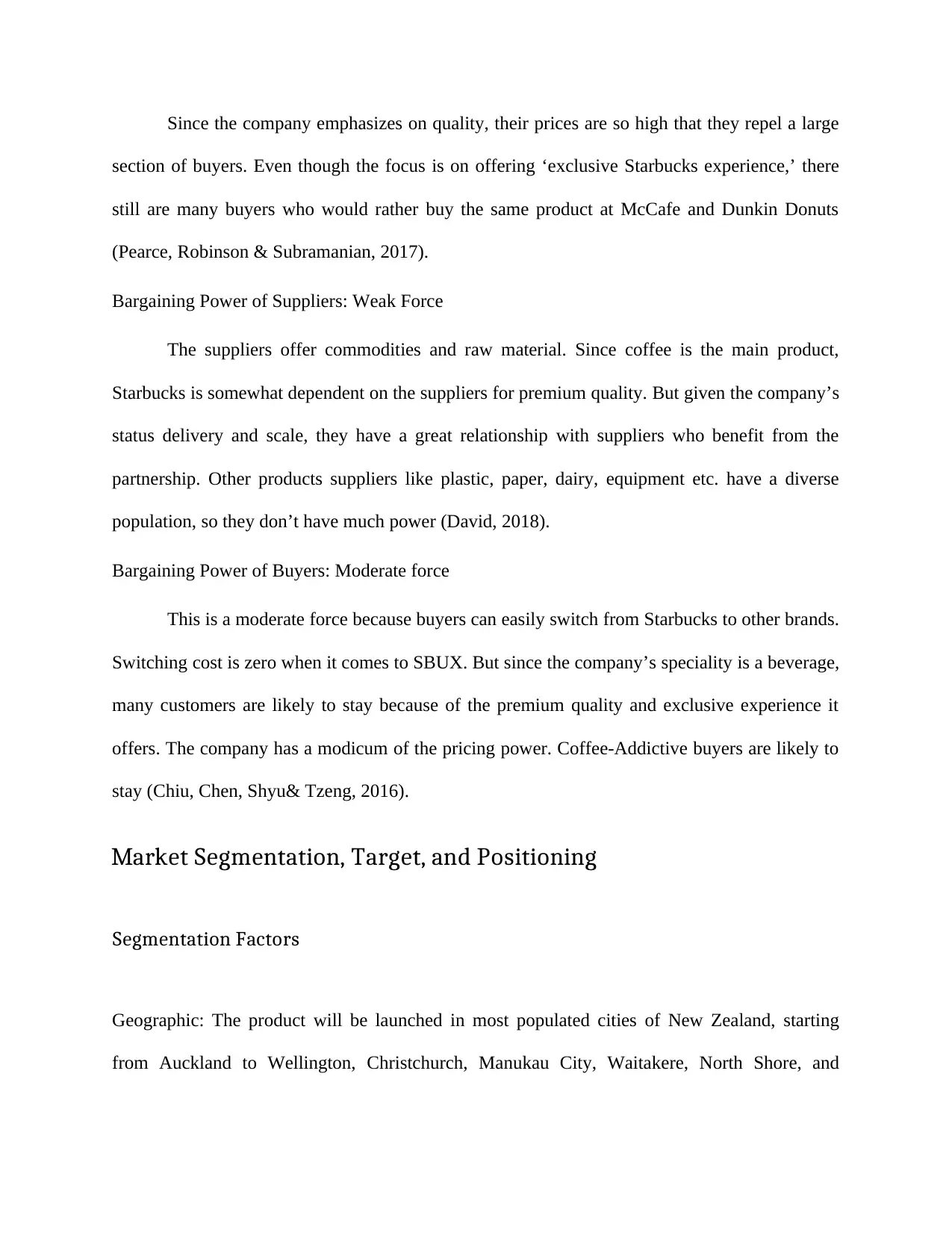
Since the company emphasizes on quality, their prices are so high that they repel a large
section of buyers. Even though the focus is on offering ‘exclusive Starbucks experience,’ there
still are many buyers who would rather buy the same product at McCafe and Dunkin Donuts
(Pearce, Robinson & Subramanian, 2017).
Bargaining Power of Suppliers: Weak Force
The suppliers offer commodities and raw material. Since coffee is the main product,
Starbucks is somewhat dependent on the suppliers for premium quality. But given the company’s
status delivery and scale, they have a great relationship with suppliers who benefit from the
partnership. Other products suppliers like plastic, paper, dairy, equipment etc. have a diverse
population, so they don’t have much power (David, 2018).
Bargaining Power of Buyers: Moderate force
This is a moderate force because buyers can easily switch from Starbucks to other brands.
Switching cost is zero when it comes to SBUX. But since the company’s speciality is a beverage,
many customers are likely to stay because of the premium quality and exclusive experience it
offers. The company has a modicum of the pricing power. Coffee-Addictive buyers are likely to
stay (Chiu, Chen, Shyu& Tzeng, 2016).
Market Segmentation, Target, and Positioning
Segmentation Factors
Geographic: The product will be launched in most populated cities of New Zealand, starting
from Auckland to Wellington, Christchurch, Manukau City, Waitakere, North Shore, and
section of buyers. Even though the focus is on offering ‘exclusive Starbucks experience,’ there
still are many buyers who would rather buy the same product at McCafe and Dunkin Donuts
(Pearce, Robinson & Subramanian, 2017).
Bargaining Power of Suppliers: Weak Force
The suppliers offer commodities and raw material. Since coffee is the main product,
Starbucks is somewhat dependent on the suppliers for premium quality. But given the company’s
status delivery and scale, they have a great relationship with suppliers who benefit from the
partnership. Other products suppliers like plastic, paper, dairy, equipment etc. have a diverse
population, so they don’t have much power (David, 2018).
Bargaining Power of Buyers: Moderate force
This is a moderate force because buyers can easily switch from Starbucks to other brands.
Switching cost is zero when it comes to SBUX. But since the company’s speciality is a beverage,
many customers are likely to stay because of the premium quality and exclusive experience it
offers. The company has a modicum of the pricing power. Coffee-Addictive buyers are likely to
stay (Chiu, Chen, Shyu& Tzeng, 2016).
Market Segmentation, Target, and Positioning
Segmentation Factors
Geographic: The product will be launched in most populated cities of New Zealand, starting
from Auckland to Wellington, Christchurch, Manukau City, Waitakere, North Shore, and
⊘ This is a preview!⊘
Do you want full access?
Subscribe today to unlock all pages.

Trusted by 1+ million students worldwide
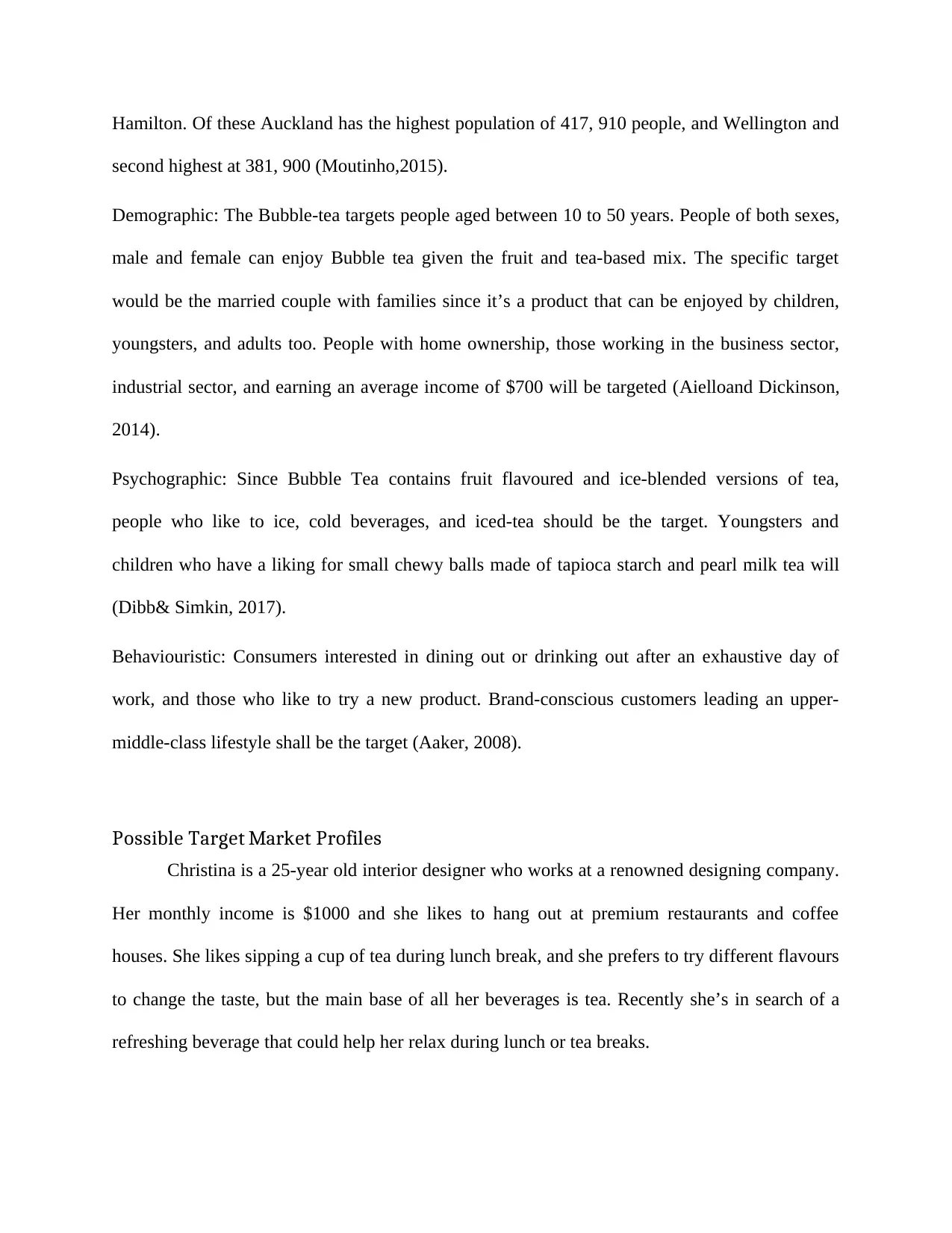
Hamilton. Of these Auckland has the highest population of 417, 910 people, and Wellington and
second highest at 381, 900 (Moutinho,2015).
Demographic: The Bubble-tea targets people aged between 10 to 50 years. People of both sexes,
male and female can enjoy Bubble tea given the fruit and tea-based mix. The specific target
would be the married couple with families since it’s a product that can be enjoyed by children,
youngsters, and adults too. People with home ownership, those working in the business sector,
industrial sector, and earning an average income of $700 will be targeted (Aielloand Dickinson,
2014).
Psychographic: Since Bubble Tea contains fruit flavoured and ice-blended versions of tea,
people who like to ice, cold beverages, and iced-tea should be the target. Youngsters and
children who have a liking for small chewy balls made of tapioca starch and pearl milk tea will
(Dibb& Simkin, 2017).
Behaviouristic: Consumers interested in dining out or drinking out after an exhaustive day of
work, and those who like to try a new product. Brand-conscious customers leading an upper-
middle-class lifestyle shall be the target (Aaker, 2008).
Possible Target Market Profiles
Christina is a 25-year old interior designer who works at a renowned designing company.
Her monthly income is $1000 and she likes to hang out at premium restaurants and coffee
houses. She likes sipping a cup of tea during lunch break, and she prefers to try different flavours
to change the taste, but the main base of all her beverages is tea. Recently she’s in search of a
refreshing beverage that could help her relax during lunch or tea breaks.
second highest at 381, 900 (Moutinho,2015).
Demographic: The Bubble-tea targets people aged between 10 to 50 years. People of both sexes,
male and female can enjoy Bubble tea given the fruit and tea-based mix. The specific target
would be the married couple with families since it’s a product that can be enjoyed by children,
youngsters, and adults too. People with home ownership, those working in the business sector,
industrial sector, and earning an average income of $700 will be targeted (Aielloand Dickinson,
2014).
Psychographic: Since Bubble Tea contains fruit flavoured and ice-blended versions of tea,
people who like to ice, cold beverages, and iced-tea should be the target. Youngsters and
children who have a liking for small chewy balls made of tapioca starch and pearl milk tea will
(Dibb& Simkin, 2017).
Behaviouristic: Consumers interested in dining out or drinking out after an exhaustive day of
work, and those who like to try a new product. Brand-conscious customers leading an upper-
middle-class lifestyle shall be the target (Aaker, 2008).
Possible Target Market Profiles
Christina is a 25-year old interior designer who works at a renowned designing company.
Her monthly income is $1000 and she likes to hang out at premium restaurants and coffee
houses. She likes sipping a cup of tea during lunch break, and she prefers to try different flavours
to change the taste, but the main base of all her beverages is tea. Recently she’s in search of a
refreshing beverage that could help her relax during lunch or tea breaks.
Paraphrase This Document
Need a fresh take? Get an instant paraphrase of this document with our AI Paraphraser
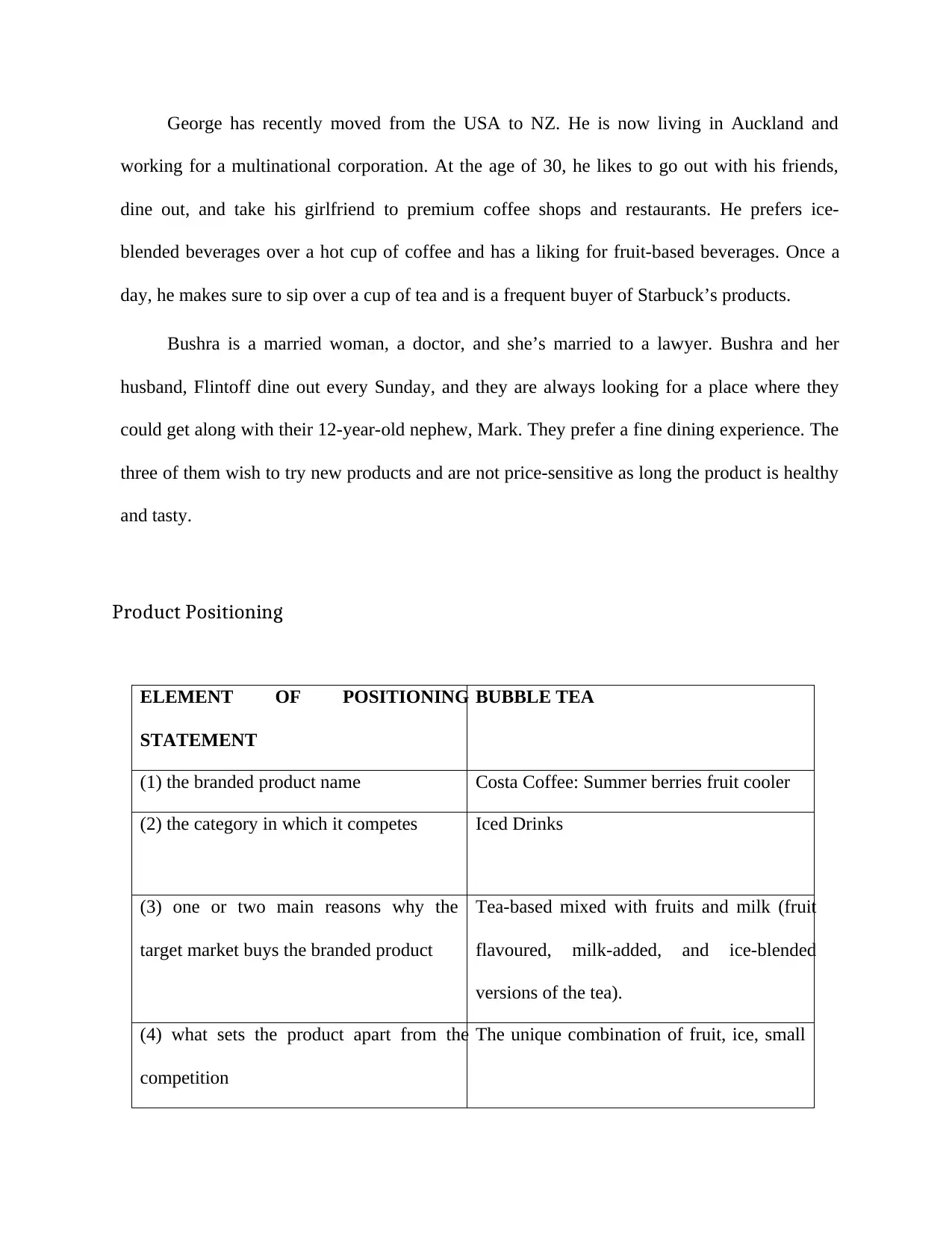
George has recently moved from the USA to NZ. He is now living in Auckland and
working for a multinational corporation. At the age of 30, he likes to go out with his friends,
dine out, and take his girlfriend to premium coffee shops and restaurants. He prefers ice-
blended beverages over a hot cup of coffee and has a liking for fruit-based beverages. Once a
day, he makes sure to sip over a cup of tea and is a frequent buyer of Starbuck’s products.
Bushra is a married woman, a doctor, and she’s married to a lawyer. Bushra and her
husband, Flintoff dine out every Sunday, and they are always looking for a place where they
could get along with their 12-year-old nephew, Mark. They prefer a fine dining experience. The
three of them wish to try new products and are not price-sensitive as long the product is healthy
and tasty.
Product Positioning
ELEMENT OF POSITIONING
STATEMENT
BUBBLE TEA
(1) the branded product name Costa Coffee: Summer berries fruit cooler
(2) the category in which it competes Iced Drinks
(3) one or two main reasons why the
target market buys the branded product
Tea-based mixed with fruits and milk (fruit
flavoured, milk-added, and ice-blended
versions of the tea).
(4) what sets the product apart from the
competition
The unique combination of fruit, ice, small
working for a multinational corporation. At the age of 30, he likes to go out with his friends,
dine out, and take his girlfriend to premium coffee shops and restaurants. He prefers ice-
blended beverages over a hot cup of coffee and has a liking for fruit-based beverages. Once a
day, he makes sure to sip over a cup of tea and is a frequent buyer of Starbuck’s products.
Bushra is a married woman, a doctor, and she’s married to a lawyer. Bushra and her
husband, Flintoff dine out every Sunday, and they are always looking for a place where they
could get along with their 12-year-old nephew, Mark. They prefer a fine dining experience. The
three of them wish to try new products and are not price-sensitive as long the product is healthy
and tasty.
Product Positioning
ELEMENT OF POSITIONING
STATEMENT
BUBBLE TEA
(1) the branded product name Costa Coffee: Summer berries fruit cooler
(2) the category in which it competes Iced Drinks
(3) one or two main reasons why the
target market buys the branded product
Tea-based mixed with fruits and milk (fruit
flavoured, milk-added, and ice-blended
versions of the tea).
(4) what sets the product apart from the
competition
The unique combination of fruit, ice, small
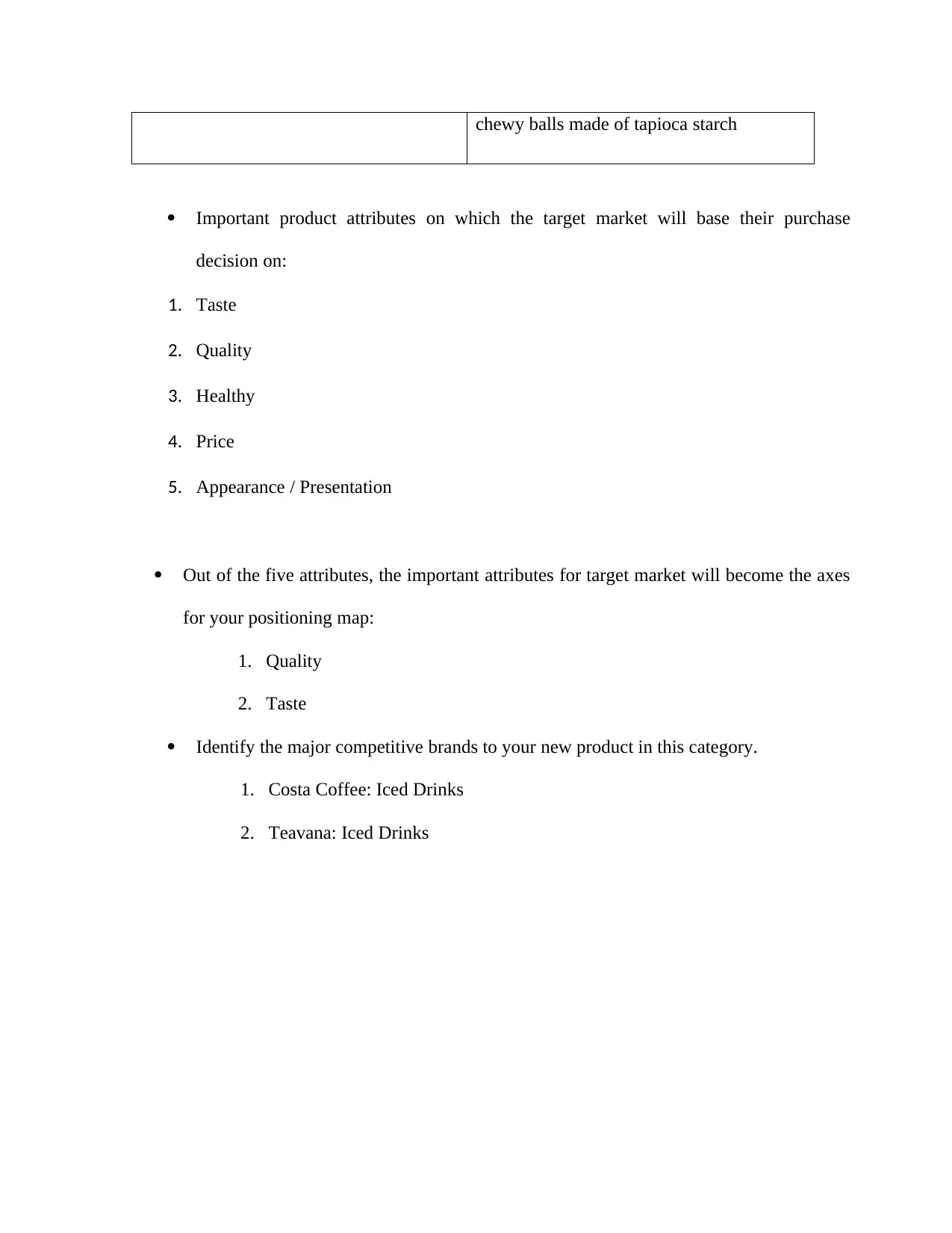
chewy balls made of tapioca starch
Important product attributes on which the target market will base their purchase
decision on:
1. Taste
2. Quality
3. Healthy
4. Price
5. Appearance / Presentation
Out of the five attributes, the important attributes for target market will become the axes
for your positioning map:
1. Quality
2. Taste
Identify the major competitive brands to your new product in this category.
1. Costa Coffee: Iced Drinks
2. Teavana: Iced Drinks
Important product attributes on which the target market will base their purchase
decision on:
1. Taste
2. Quality
3. Healthy
4. Price
5. Appearance / Presentation
Out of the five attributes, the important attributes for target market will become the axes
for your positioning map:
1. Quality
2. Taste
Identify the major competitive brands to your new product in this category.
1. Costa Coffee: Iced Drinks
2. Teavana: Iced Drinks
⊘ This is a preview!⊘
Do you want full access?
Subscribe today to unlock all pages.

Trusted by 1+ million students worldwide
1 out of 24
Related Documents
Your All-in-One AI-Powered Toolkit for Academic Success.
+13062052269
info@desklib.com
Available 24*7 on WhatsApp / Email
![[object Object]](/_next/static/media/star-bottom.7253800d.svg)
Unlock your academic potential
Copyright © 2020–2025 A2Z Services. All Rights Reserved. Developed and managed by ZUCOL.





